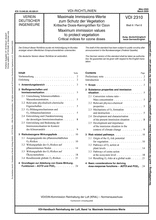Standards Worldwide
Standards Worldwide
Phone +49 30 58885700-07

Technical rule [CURRENT]
VDI 2310 Blatt 6:2020-03
Maximum immission values to protect vegetation - Critical indices for ozone doses
- German title
- Maximale Immissions-Werte zum Schutz der Vegetation - Kritische Dosis-Kenngrößen für Ozon
- Publication date
- 2020-03
- Product with additional digital content.
-
PDF, EXCEL
Additional digitale content will be provided based on format and purchase option. Please note any information in the document. - Original language
- German, English
- Pages
- 75
- Publication date
- 2020-03
- Product with additional digital content.
-
PDF, EXCEL
Additional digitale content will be provided based on format and purchase option. Please note any information in the document. - Original language
- German, English
- Pages
- 75
Product information on this site:
Quick delivery via download or delivery service
Buy securely with a credit card or pay upon receipt of invoice
All transactions are encrypted
Short description
Tropospheric ozone (O3) is an important constituent of photochemical smog. Besides its harmful effect on human health, it is currently considered to be the most significant phytotoxic pollutant of the atmosphere. Recently, two types of approaches are available for assessing (O3) risk to vegetation: one is based on the exposure concentration and can theoretically be applied to all species of the plant kingdom and a second approach is based on the cumulative stomatal (O3) uptake. This applies to all stomatous target plants, and thus comprises all higher taxa of the plant kingdom, especially vascular plants. The standard reflects the current scientific knowledge, describes and defines critical levels for (O3) for crops, species-rich grassland, and forests, and derives target values using prediction intervals. Wheat, grassland species such as red clover or harebell, and beech are considered as (O3) sensitive representatives for the mentioned vegetation types. The risk assessment is based on the estimation of stomatal (O3) uptake using receptor-specific deposition models together with dose-response relationships established for the relevant effect indicators.
Content
ICS
13.040.20,
65.020.01
Also available in
Loading recommended items...
Loading recommended items...
Loading recommended items...
Loading recommended items...
